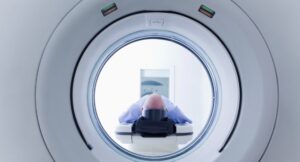To keep an eye on some of the world’s most dangerous infectious diseases, scientists rely on reports from the Global Measles and Rubella Laboratory Network. Known affectionately as Gremlin, it’s a grouping of more than 700 international labs that test about 500,000 patient samples annually. Gremlin monitors the prevalence of a huge range of pathogens in addition to those in its full name, including Covid-19, RSV, dengue, yellow fever and Ebola. And it does so on a remarkably modest budget: just $8 million a year, or less than 10% of the price tag for a single F-35 fighter jet.
Yet the program, which is managed by the World Health Organization, is suddenly on the brink of extinction. Gremlin depends on money from the Centers for Disease Control and Prevention, the flagship US public-health agency. Since its establishment in 1946, the Atlanta-based CDC has worked on the front lines of every significant infectious disease outbreak, and if any of the threats that Gremlin tracks become a major problem, the agency will be expected to play the same role again. But shortly after President Donald Trump’s inauguration on Jan. 20, the lab network’s staff learned its future was in doubt, because the US had pulled its funding, prompting an urgent scramble to find alternative donors.
The decision was a small but significant example of the uncertainty engulfing the CDC, which now answers to Robert F. Kennedy Jr.—a longtime promoter of false claims about vaccine safety, along with other pseudoscientific notions, who was confirmed as the US secretary of health and human services on Feb. 13. As many as 700 CDC employees have been told they will lose their jobs, including hands-on scientists and lab personnel. Many were informed of their terminations in emails that said their “performance has not been adequate to justify further employment.”
The CDC has also been ordered to stop communicating entirely with the WHO, a United Nations body that, whatever its missteps during the coronavirus pandemic, remains the main global venue for coordinating public-health policies and sharing related information. Late last month, CDC influenza experts almost missed the international summit where scientists debate the composition of coming flu vaccines, confirming their participation with just 48 hours’ notice. And for a time, agency web pages containing vital health data were disappearing so fast that independent researchers began a crash effort to back them up and determine which information had been purged or altered.
A spokesman for the CDC declined to comment for this story; HHS did not respond to a request for comment.
The Trump administration’s changes to the CDC—some of them directed by Elon Musk’s Department of Government Efficiency, which is not an official department but an office under the purview of the White House—are occurring at a risky moment. The US is experiencing its most severe flu season in 15 years, leading to an estimated 430,000 hospitalizations and 19,000 deaths since October. Cases of measles have surged amid declining vaccination rates, and an outbreak of the potentially fatal, hypercontagious virus is causing hospitalizations and has resulted in at least one death in Texas. Then there’s H5N1, the pathogen better known as bird flu. The virus has spread widely on poultry farms, pushing up egg prices, and is increasingly infecting dairy cows and small numbers of humans. As it becomes more common, the risk of a mutation that could create a pandemic strain is rising.
Musk, Trump and their allies have said these overhauls are needed to rein in unnecessary spending and refocus the government on core priorities. Kennedy, for his part, suggested during his Senate confirmation hearing that he wants to shift federal research toward chronic illnesses, offsetting what he characterized as an excessive focus on infectious disease. But according to scientists and public-health experts interviewed by Bloomberg Businessweek, the programs being targeted at the CDC and other health and science agencies are anything but wasteful—and gutting them means more people will die from preventable or treatable conditions.
“This is the worst scenario I can possibly imagine,” says Angela Rasmussen, a virologist at the University of Saskatchewan in Canada who’s co-editor-in-chief of the journal Vaccine. “It’s difficult to quantify how many lives will be destroyed.”
Before Trump’s inauguration, the US government’s public-health efforts were anchored by three major institutions. The CDC tracked and responded to acute health threats, particularly from infectious disease, at home and abroad. Its sister agency, the National Institutes of Health, provided as much as $47 billion annually for biomedical research, funding studies at its own labs and US academic institutions. And the US Agency for International Development worked to strengthen health-care systems and deliver treatments around the world—including American-developed HIV therapies that have helped millions in sub-Saharan Africa.
While public health is an intensely collaborative enterprise, with practitioners in constant communication with international colleagues, the US role was unique. “Across the proverbial value chain—developing products, approving them, providing guidance, establishing infrastructure for delivery and maintaining surveillance systems to ensure global safety—the US may not be the only actor, but it is a driver in every one of those areas,” says Mitchell Warren, the executive director of AVAC, a New York-based organization that advocates for HIV prevention research. This infrastructure provided an economic benefit—medical research supports more than 400,000 American jobs—and ensured the US government was among the very first to know about new, potentially society-altering health threats.
Some of its key components are now undergoing what Musk might call “rapid unscheduled disassembly”—a term used by his company SpaceX after rocket explosions. Almost all of USAID’s staff is being laid off or put on administrative leave, and what few overseas-development programs survive will likely be folded into the Department of State. The process for seeking NIH grants is partially frozen, and the agency has moved to sharply reduce what it contributes to researchers’ indirect costs, such as lab maintenance and IT support. (Musk has derided such costs as “a ripoff.”) The end or curtailment of both agencies’ operations is likely to create an opportunity for China, which is a major provider of foreign aid and spends increasing amounts on biomedical research.
But the transformation of the CDC will have the most immediate impact. Among other things, it serves as a giant intelligence apparatus, monitoring data from every part of the world to identify worrying trends and respond before they grow severe. These surveillance functions were among the first to break down after Trump took control of the federal government. In late January the CDC failed—for the first time ever—to release its Morbidity and Mortality Weekly Report, a digest of public-health news that doctors and policymakers have relied on, in various guises, for more than a century. It also stopped sharing data via FluNet and FluID, platforms that track influenza.
Like the Gremlin lab network, FluNet and FluID are administered by the WHO. Trump signed an executive order withdrawing the US from the UN body on his first day in office, citing its “mishandling” of Covid and “failure to adopt urgently needed reforms.” Communication with the CDC stopped around Jan. 24, Maria Van Kerkhove, the WHO’s interim director of epidemic and pandemic preparedness and prevention, told reporters in Geneva on Feb. 12.
The WHO also coordinates the process of selecting strains for seasonal flu vaccines, relying on information supplied by some 130 countries. (The shots need to be updated regularly to remain effective.) In February it convened a long-planned advisory committee meeting in London, which would normally be attended by as many as five CDC representatives. This year officials weren’t sure until almost the last minute whether anyone from the agency would show up or send a package of data that it regularly supplies to guide discussion.
In the end, the CDC provided the data, and its staff joined by videoconference. It’s unclear whether they received a formal waiver from the Trump administration to participate in a WHO process, or whether CDC experts will be prohibited from doing so in the future, a prospect that influenza experts find alarming. Failing to take part wouldn’t just deprive other countries of American expertise. It could also reduce the information available to the US government as it prepares for future flu seasons. “If we are to disengage from the WHO, we will be flying blind,” says Nancy Cox, a virologist who led CDC flu programs for more than 20 years. Already the Trump administration has canceled a March meeting of the Food and Drug Administration’s vaccine advisory committee, where flu-shot plans were to be discussed.
What really worries some of Cox’s peers, however, is the less familiar threat of bird flu. So far the main effects of H5N1 have been on farm animals and wildlife. The relatively small number of humans infected have largely been farmworkers and their symptoms mostly mild. But there’s evidence that the pathogen could be spreading undetected. A recent CDC study—published in mid-February after an unexplained two-week delay—reported on the cases of three bovine veterinarians who’d unknowingly contracted it. Alarmingly, one of them worked in Georgia and South Carolina, states that haven’t officially reported H5N1 outbreaks on dairy farms.
The Trump administration has said that containing bird flu remains a priority. Still, that effort isn’t immune to the cost-cutting campaign. Several US Department of Agriculture employees working on bird flu were recently fired by accident; the agency says it’s “working swiftly to rectify the situation.” The government is also reviewing a $590 million contract for an H5N1 vaccine from Moderna Inc., people familiar with the matter told Bloomberg News. If it’s canceled, final-stage trials of the inoculation may not go forward.
The nightmare scenario is one that virologists have feared ever since H5N1 was first identified in humans in the 1990s: that it will swap genes with seasonal flu, creating a more virulent strain that can easily spread between people. This is a theoretical possibility whenever a host, whether human or animal, is infected with both bird flu and seasonal flu simultaneously. That’s obviously more likely to happen when both viruses are in wide circulation, as they now are in many parts of the US.
The risk of such a combination is “low until it changes,” says Marion Koopmans, the head of virology studies at Erasmus University in Rotterdam. “How do you know it changes if you’re not really scrutinizing? That’s the worry. We rely on proper surveillance, which in this situation should be really enhanced.” Without such monitoring, a serious outbreak might be detected only when sick patients begin to overwhelm hospitals.
The full scope of the administration’s plans for the CDC will likely become clearer in the coming weeks, as the furious pace of DOGE-related changes slows and Kennedy consolidates his control. His views could not be more at odds with those of the scientists working under him; in addition to his anti-vaccine advocacy, he has questioned the well-established link between HIV and AIDS and falsely suggested Covid was “targeted to attack Caucasians and Black people.” (Kennedy said in a recent interview that HHS employees engaging in “good science” have “nothing to worry about.”)
What’s almost certain is that, over the next four years, the CDC will be smaller, less well resourced and more reticent about foreign partnerships. It’s also likely to lose some of its best employees, whether through layoffs or voluntary departures: Many could earn considerably more than their government salaries at university labs or pharmaceutical companies. Whether such a downsized, demoralized agency is able to respond to emerging health threats—or, at worst, another pandemic—will be known only when it’s tested.
“There are inefficiencies we should address, and we should always be open to new approaches and ideas,” says Harlan Krumholz, director of the Yale New Haven Hospital Center for Outcomes Research & Evaluation, an academic group that advises hospitals and governments on patient care. “At the same time, it’s important to recognize that we’ve built a jewel of a system—a remarkable engine of discovery that supports countless breakthroughs and partnerships across the globe. If we’re not careful, we risk dismantling something that’s taken decades to build.” Bloomberg









